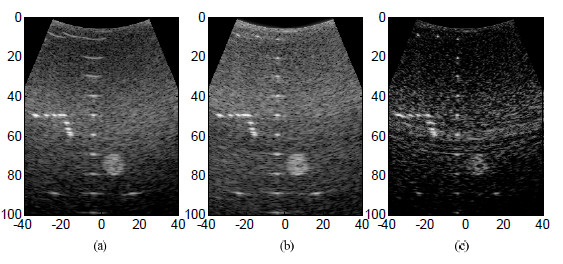Keyword: Ultrasonic imaging, Virtual source, Bidirectional point-wise focusing
Ultrasonic imaging is widely used in medical imaging and industrial detection. Higher qualities of ultrasonic imaging are needed for reliable examination of patients or detection of defects in industrial products. Many studies have been done for improving the imaging resolution and contrast.
In conventional ultrasonic imaging of fixed-focus transmitting and fixed-focusing receiving (fix-fixR) or dynamic-focusing receiving, high resolution can be only obtained near the focuses. The width of main lobe increases and the lateral resolution decreases as the depth of imaging increases. Imaging algorithms based on the virtual source (VS) was proposed for higher resolution. However, at sometime, the low resolution scan lines based on VS cannot be added coherently.
To solve this problem, the adaptive bi-directional point-wise focusing (ABIPF) method combining the VS imaging and coherent weighting is proposed. In this algorithm, the requirements of the front-end hardware are much lower than conventional ultrasonic imaging method and the lateral resolution and contrast are more consistent in the whole plane.

Fig. 1 Imaging results (a) fixT-fixR (b) BIPF (c) ABIPF (Image by WU)
In this method, ultrasonic array is divided into sub-arrays, the ultrasonic RF scanning lines are collected using fixed-focusing transmitting and receiving and these focuses are considered as VS. In the following, these scanning lines are point-wise focused using adaptive weighting, and then high-quality image is obtained. Two other algorithms are compared with the ABIPF algorithm to validate the performance shown in Fig. 1.
Simulations for point and speckle targets are used to verify this algorithm. It proves that when the F number is 1.5 and the focus is at 10 mm (such a sub-aperture corresponds to only 17 elements of array), the quality of images at different depths are consistent and equal to that of fixed-focus transmitting and dynamic receiving algorithm based on 64-channel imaging system.
The experiment results prove that the image is much clearer on the whole by the proposed algorithm. It can help improve detection accuracy in medical and industrial detection.
References:
WU Wentao, HAN Xiaoli, LI Ping, LIN Jing. Ultrasonic Virtual Source Imaging Based on Adaptive Bi-directional Point-wise Focusing. Piezoelectricity, Acoustic Waves, and Device Applications (SPAWDA), 2014 Symposium on, ISBN 978-1-4799-6424-6, IEEE (pp. 419-422, Oct. 30 2014-Nov. 2, 2014, Beijing, China). DOI: 10.1109/SPAWDA.2014.6998614
Contact:
WU Wentao
Institute of Acoustics, Chinese Academy of Sciences, 100190 Beijing, China
Email: wuwentao@mail.ioa.ac.cn


